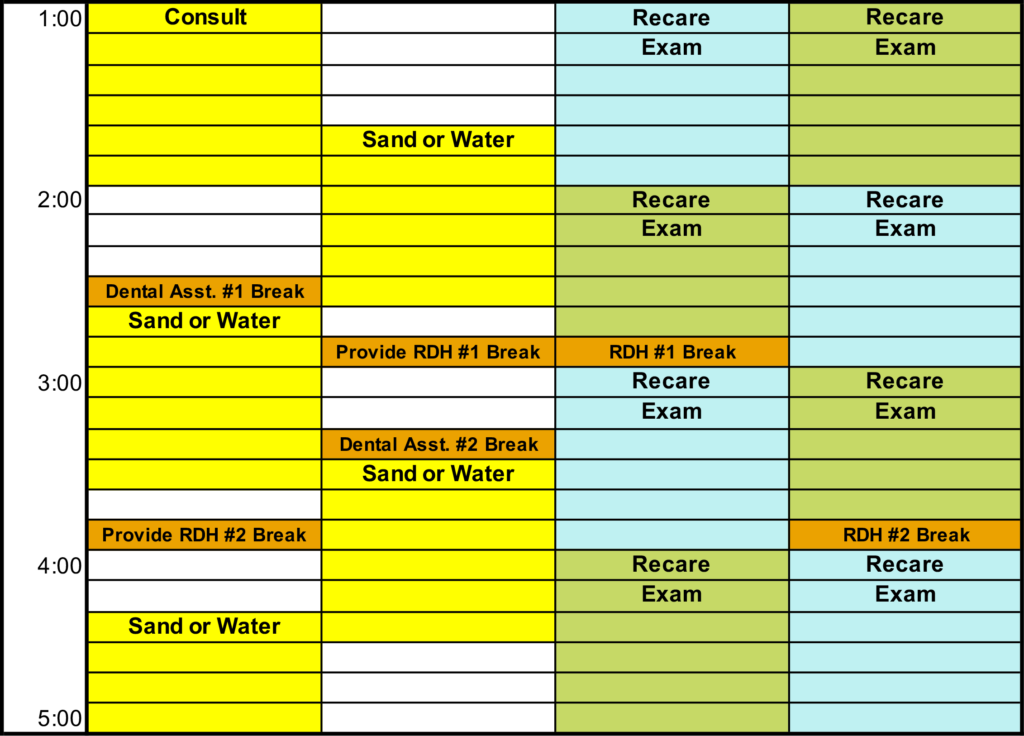Crisis Management
Keeping Your Team Strong During the COVID-19 Crisis
The coronavirus pandemic quickly altered dental practices across the nation. It’s likely your practice closed temporarily; laying off the majority of staff members and returning to work has seen increased sterilization and PPE requirements. Pent up demand from patients has resulted in busier-than-normal schedules. All of these things mean you need to look at this situation from a crisis management standpoint.
It is not lost on office managers and dentists that this is a physically and emotionally difficult time for team members. Not only are they feeling the strain of increased expectations, learning to work with the added discomfort, headaches, fatigue, and the increased body temperature additional PPE creates, they may also have real health fears of contracting the virus. Some employees may be questioning their future in dental care or looking at employment changes to other practices to see if the grass may be greener.
Compounding this are the economic impacts of the crisis and more uncertainty about the future than many have ever experienced. Missteps throughout the day, once easily overcome, feel insurmountable when tensions and stress levels are high. Every little thing brings your team members one step closer to their breaking point. Fortunately, there are steps you can take to reduce fear and anxiety, creating a stronger sense of team and belonging.
Discuss Burnout Openly
The World Health Organization defines burnout as a phenomenon resulting as a reaction to repeated stress. Burnout manifests as a loss of energy, increased desire to take a mental break from co-workers, feelings of negativity, and loss of productivity and/or efficiency in the workplace. Exercising empathy with patients and engaging in conversation about their life issues, both positive and negative, lends to “compassion fatigue,” which compounds the overall feeling of career burnout. Employees may not realize they are dealing with burnout and may instead believe they are just struggling to keep up during stressful times. Staff members may feel less stressed when understanding the phenomenon they feel is well documented and felt by many others in the medical and dental field. Share signs and symptoms with your team so they can identify and label what they may be experiencing:
- Headaches, body heat, and fatigue from added PPE
- Reduced efficiency and energy
- Increased errors
- Increased frustration
- Irritability
- More time spent working with less accomplished
Empathize with the feelings of burnout; then turn the topic of discussion to crisis management – ways to improve the work environment to reduce stress and uncertainty.
Provide Clear Guidance
Inform and reassure staff members of the guidance you are following to ensure safety, including your state health department mandates, the ADA, and CDC. Review the protocols and determine which recommendations from the ADA and the CDC you will incorporate.
This is a confusing time when recommendations conflict with each other. Help address ambiguity by providing clear guidance to the dental team. Incorporate training on the use of new PPE, including donning/doffing protocols, seal checks for masks, and other training. Training links can be found on the Pandemic Recovery Guide. Additionally, be sure to share protocols for handling a sick employee with your entire team so no one is surprised by the procedures.
Crisis Management = Frequent Communication
Social distancing and busy schedules have often led to reduced communication. Now is the time to communicate more frequently than ever before. Consider:
- One-hour staff meetings every 2 weeks with 30 minutes of open forum time for staff to express concerns. Empower the team to brainstorm solutions together.
- Help your team understand the value they bring to your patients and the practice.
- Encourage support and respect within the team.
- Check in weekly with each team member one-on-one. What would be most valuable for them right now to cope?
- Be genuine and sincere in your communication – speaking slowly, in a soft tone, conveys that you are speaking from your heart rather than a script. Listen with the intent to understand. Ask for suggestions through well-prepared questions and find yourself in the role of an active listener, not interrupting, just listening, and taking notes.
- What is your suggestion to reduce stress in the practice?
- If you could institute just one change to improve team morale while maintaining patient care, what would it be?
- What aspects of scheduling are making it difficult to work in the clinic?
- How many patients still need to be contacted and rescheduled following our closure?
Schedule Breaks
Breaks may be the single most appreciated change incorporated to reduce stress. PPE is hot! Team members need a break every couple of hours to remove their PPE and hydrate. State laws vary in regard to mandated breaks, yet it is fairly common for dental team members not to have access to a scheduled break – even when required by law.
Treating patients during COVID-19 is still evolving, but it’s likely the added PPE is here to stay. Place a break in the schedule so it is visible every couple of hours. This may require another staff member to be on point to relieve clinicians for their break time. Scheduling breaks daily will signal to staff members they are equally as important to the practice as patients. If possible, identify an area that can be a quiet space for employees who are overwhelmed to find calm and collect themselves. Include disinfecting wipes for employees to wipe down the shared space between uses.
Provide drinks and snacks in the lunchroom to let staff make the most of those 10-minute breaks.
Providing breaks does not mean you need to extend appointment times or block out productive patient time; it means the team works together at a higher level. You can block the first or last 10 minutes in a hygiene schedule with a note the dental assistant, sterilization technician, or infection control coordinator, will take over for the exam at that time to provide the break. Front office team members can generally work together to make sure everyone in their small team has access to a break. Ideally, note the blocks in the schedule for a visual reminder the break is to take place and someone may be “out of service” for 10 minutes. In this example, the dental assistant sits for the exam during the last 10 minutes of the hygiene visit. Scheduling protocols do not need to change. Schedule patients according to existing protocols, and weave in the breaks as in the example below.

Hire an Infection Control Coordinator
This role is responsible for staying up-to-date with state and Department of Health regulations as well as CDC and ADA recommendations for treatment during the COVID-19 era. They provide what was historically sterilization technician duties with the following added responsibilities:
- Stay current with changes to OSHA, Department of Health mandates and ADA and CDC recommendations.
- Maintain staff training documentation.
- Prepare a Respiratory Protection Plan if offering N95 or equivalent respirators to staff.
- Arrange for initial fit testing and annual testing when applicable for respirators.
- Turn over Ops to include all added disinfectant protocols.
- Oversee disinfection and sterilization of patient care items.
- Provide breaks for team members as needed.
Gain Feedback and Provide Control
COVID-19 has created a variety of new protocols, PPE, patient care management, and scheduling guidelines. For employees, it can feel as though there is a tremendous loss of control where new rules dictate every aspect of their work environment making crisis management an important next step. Find ways to return some control to your employees. Resist the temptation to make decisions in a vacuum and “inform” staff members of new rules and guidelines. Instead, solicit feedback from the team before making changes; let them become a part of the process. Their input may adjust some of the guidelines you are currently considering.
- Use monthly meeting times to discuss possible changes.
- Discuss and reinforce the practice’s purpose and goals and the role each team member plays in achieving these.
Promote Healthy Team Communication Skills
This is a very stressful time to be practicing dentistry. Practice kindness when communicating with colleagues who also feel stress during this time. Keep your end objective for the conversation in mind; this can help eliminate emotional conversations. For example, if you are having a scheduling challenge, define your objective to implement better scheduling protocols, and design your conversation around the objective rather than the emotion of being frustrated. For example: “I’d like to make sure we implement breaks to help reduce stress for everyone” vs. “I’m tired of not getting a break,” “others get a break and I don’t,” “I’m not appreciated enough to have a break,” “I’m always coming into a day that’s scheduled wrong,” etc. While all examples may express the emotion behind the frustration, the first example gets to the endpoint without creating defensiveness or hurt feelings.
- Word Choice is also important to reduce stress and not trigger defensiveness on behalf of the listener. Phrases such as “she was under stress” vs. “she was mad” “she was super mad” or “she attacked me” could all describe the same event but have different contexts and serve to de-escalate or escalate the emotions involved. Careful word choice can create healthy dialogue to resolve the challenge rather than escalate it.
- An added bonus – communicating in a courteous, conscientious and generally business-like manner will allow your colleagues to perceive you in a more professional manner.
Stress and anxiety often make it less likely for us to understand a different perspective. Collaboration in a practice can shut down as a result. All the more reason to encourage skillful communication.
Focus on Facts
COVID-19 has dominated the news and social media channels increasing the need for crisis management. At times, the information feels overwhelming, possibly even exaggerated through news sources. Facebook groups can easily agitate the reader as people post about their fears and what they think is happening in the industry. Focus on reliable information your team can follow as part of your staff meetings to follow the facts without the fear and understand what is happening in your area. Use reliable sources:
- John Hopkins University updates its critical trend maps daily, including a state-by-state “Are we flattening the Curve?” map that is easy to follow and understand at a glance.
- ADA.org
- CDC.gov
Review Benefits
Remind team members of their benefits and how a positive COVID-19 diagnosis from a team member, doctor, or patient will be handled in the practice.
- Review their rights under the Families First Coronavirus Response Act.
- Consider adding a “Wellness Day” to your benefits package.
- Consider hosting an online training on health or wellness topics for your employees.
